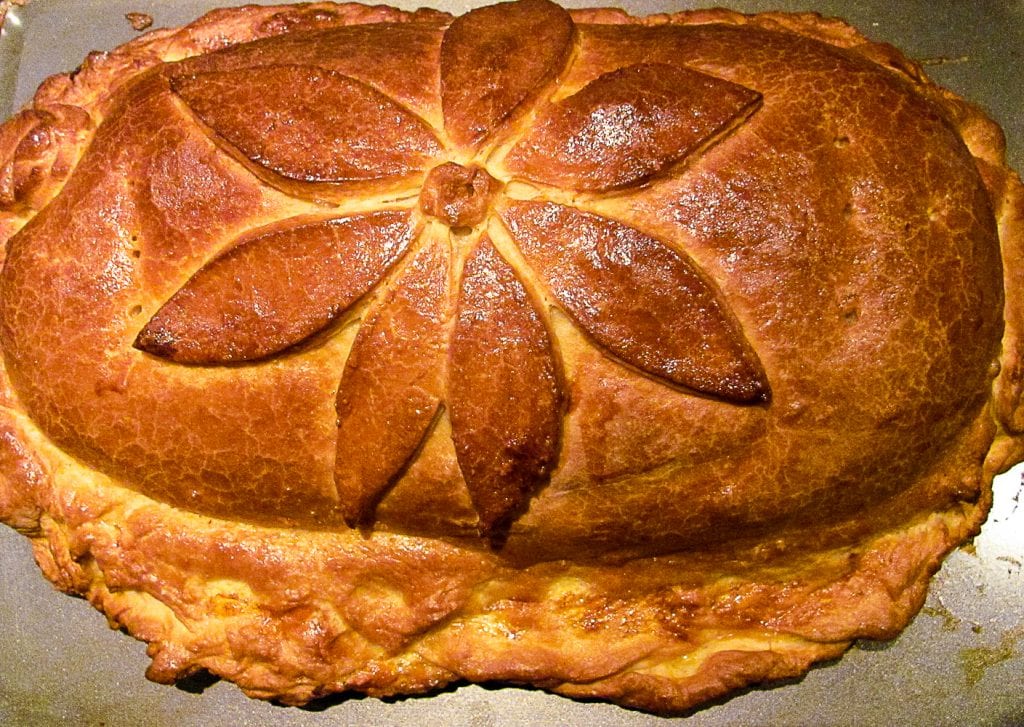Russia’s Rectangular Pie!
The world of culinary practitioners is firmly divided into cooks and bakers. I’m a cook. I can confidentially construct omelets, soups or stews without ever even peeking at a cookbook. I become all thumbs, however, when faced with turning flour, butter, eggs and sugar into crust. So it was with a certain amount of trepidation that I agreed to attempt Salmon Coulibiac – the king of pies, a magnificent creation of fish, rice, and…(Oh rage and despair) pastry!
Coulibiac means literally “rectangular pie” made from three fundamental Russian ingredients – fish, grains, and bread – and in Russia is served together with Ukha or fish soup. Traditional recipes use buckwheat kasha as the crucial absorbent grain substance, though today rice is more common. Unlike Beef Stroganoff, coulibiac is a Russian dish, which was imported to France, appearing first in Plumerey’s “L’Art de la Cuisine Francaise Au XIXe siècle (1833-1844)” as “coulibiac.” French and later English versions of the dish replace traditional Russian brioche-type like dough, with a lighter, layered pate brisee. Where traditional Russian recipes call for layers of grain and flaked fish, French and English chefs often show off with a whole poached salmon inside the pastry.
Russia’s great writer Anton Chekhov was a coulibiac enthusiast, and left these strict instructions to any chef bold enough to attempt a coulibiac:
The coulibiac must make your mouth water, it must lie there before you – a shameless temptation…butter drips like tears, and the filling is fat, juicy, rich…
With that in mind, let’s get to work! This is a time-consuming dish, but well worth the effort. The fillings can be made ahead of time and warmed to room temperatures prior to assembly, but the dough should be used as soon as it is ready.
Salmon CoulibiacIngredients:175 ml of warm milk 70 gms of butter 1 envelope of active dry yeast 1-½ Tbl grams of sugar 60 ml of warm water 1 large egg, plus 2 large egg yolks 1 teaspoon of salt 460 grams of flour Directions:1. Combine the sugar, water, and yeast. Set in a warm place to proof for 10-15 minutes. 2. Combine the milk and the butter in a saucepan and bring to the boil. Remove from heat and cool to 45°C. 3. Beat the eggs and egg yolks until creamy, then combine them with the cooled milk mixture and yeast. 4. Place dry ingredients into a food processor fitted with a steel blade. As the processor is running, add the liquid mixture until the dough clings together. 5. Turn out onto a floured surface and knead briefly into a ball. 6. Place dough in a buttered bowl, and cover with a linen towel and set in a draft less, warm place. Let rise until it doubles (1 ½ hours). 7. When the dough has risen, punch it down, then let rise an additional 45 minutes. Make the Coulibiac Filling:1 kilo of boneless salmon fillets, skin removed, sliced into 2 centimeter thick pieces 1 cup of white rice cooked in 2 cups fish or chicken stock 500 gms of white fish (cod or haddock) de-boned, skin removed 1 medium yellow onion, and one bunch of scallions diced finely Salt and pepper to taste 200 ml of dry white wine 1 half of a fresh lemon 500 ml of reserved pan juices (see below) 4 Tbls of flour 50 ml of crème Fraiche or Russian sour cream 50 grams of unsalted butter 150 grams of melted butter Fresh Parsley and dill chopped – a generous handful of each For the glaze: 1 egg, 2 Tbls of Vegetable oil and 2Tbl of water, combined Directions:1. Cook the rice and set aside. 2. Sweat the onions and scallions in 10 grams of melted butter until translucent. Set aside. 3. Melt 10 grams of butter in a flat-bottomed skillet. Sautee the white fish fillets for 5 minutes on each side. Remove fillets to a plate with a paper napkin to cool. 5. Heat the remainder of the white wine, juice of the lemon and a sprig of dill in the de-glazed skillet until simmering. Place the salmon fillets into the simmering wine and poach covered for approximately 8 minutes. Remove to a plate with paper towels to cool, and then flake with the backside of a fork. Pour the remaining pan juices into a jug and set aside. 6. Combine 2 Tbls of flour with 20 grams of butter into a roux in the skillet and heat carefully until mixture is foaming. 7. In small amounts, add the reserved pan juices to the roux as you beat with a whisk to combine and thicken. When all the pan juices (don’t use more than a total of 500 ml) have all been absorbed, reduce heat and stir to thicken. Add the crème Fraiche or sour cream. Assembling the Coulibiac1. Melt the remaining butter in a saucepan. 2. Turn half of the dough on to a floured surface and roll into a long oval (50 centimeters) 3. Spoon half of the rice filling within the oval (leaving a 5-centimeter edge) and sprinkle with a few spoonfuls of butter. Top with the salmon, then the remainder of the rice filling. Cover with more melted butter. 5. Roll out the other half of the dough into an oval, and carefully place it over the loaf. Cut off any excess dough. 6. Crimp the edges and use the dough scraps to make decorative designs on top of the coulibiac. 7. Cover with a linen towel and set to rise 40 minutes in a warm place. 8. While the coulibiac is rising, pre-heat the oven to 190°C. 9. Brush the glaze mixture all over the coulibiac. Prick holes (at least 6) in the top of the coulibiac to allow steam to escape then place in the center of the preheated oven and cook for 45 minutes until the crust is golden brown. |










Beautiful! I’m totally with you in the cook v. bake struggle… but photographic evidence seems to prove that you’re doing quite well in the russian meat-pastry category 🙂
У меня текут слюньки!